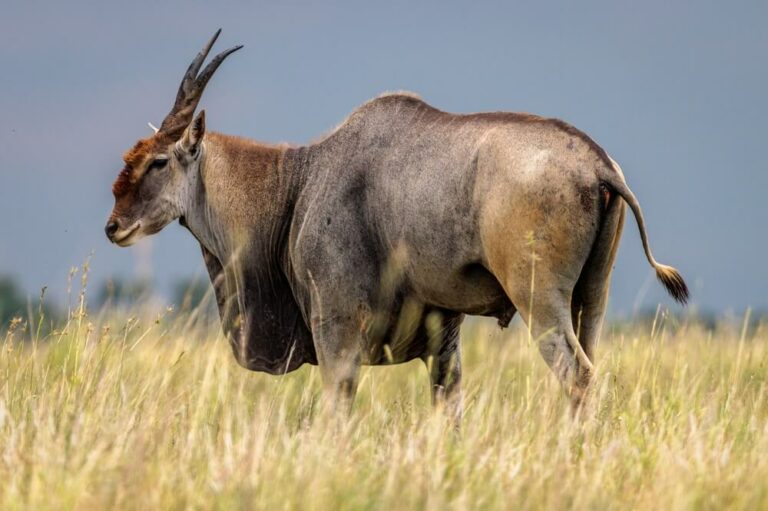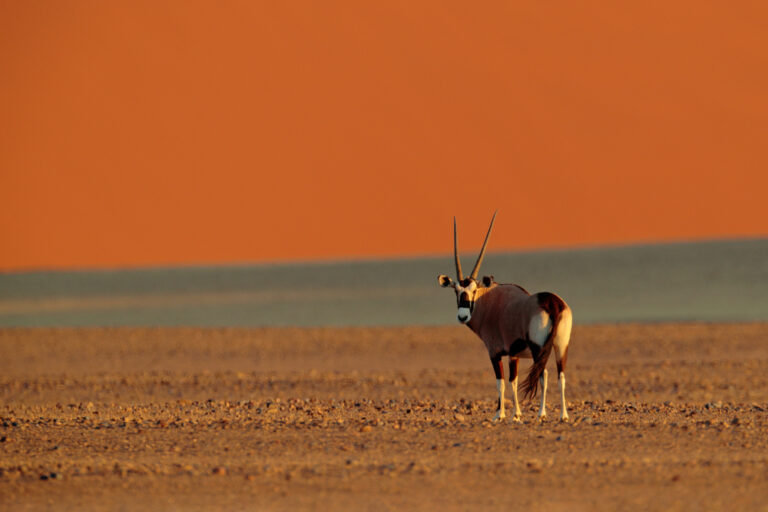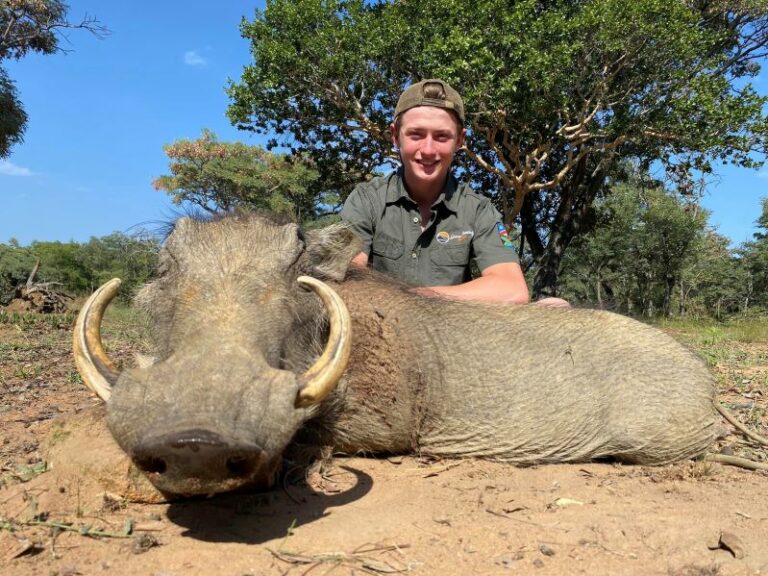The words African hunting trophies typically conjure images of record-breaking prize animals, a reward for the time, effort, energy, and sacrifice that went into the hunt. A pat on the back in return for hours under the harsh African sun, and the miles of tracking through bush, sand, and rough terrain.
Traditionally, these trophies take the form of big game hunting prizes like the Lion, Elephant, and Leopard. But while these species still prove immensely popular with hunters worldwide, there is another world of African plains game sure to deliver on trophy quality and provide a great story of when the hunter went trophy hunting in Africa.
[DYNAMIC-BLOGTABLEOFCONTENT]
Key Takeaways
- The African continent is home to a variety of trophy animals.
- There is a trophy hunt for almost every level of hunting competency.
- Not all trophies are physically big, but all still deliver.
- The hunt you choose will dictate your approach.
- Africa’s well-organized hunting industry ensures your focus can be on the plains – not on the paperwork.
Traditional African Hunting Trophies: Those of hunting Legend and Lore
Since the dawn of the hunt, big game hunting in Africa has been the goal of almost any hunter who has picked up a rifle. These trophies are the ones that dreams, heroes, and campfire tales are built on. The animals that test a hunter’s determination, patience, and skill….the Cape Buffalo.
Some of these historic hunting adventure targets stand out more than others, for both their persona and the bragging rights afforded to those who successfully bring them down.
Cape Buffalo (Syncerus caffer caffer)
Africa’s Black Death. Widowmaker. Bush Mafia. An animal afforded these nicknames is one deserving of respect and admiration.
Adult males can weigh up to 2,000 pounds. with some managing an impressive 60+ inch horn measurement. Horns are measured from tip to tip across the head over the boss. These landmarks of the African hunting safari are best hunted in the drier seasons when grasses and bush are shorter and water scarcer, which leads to larger herds condensing themselves around drinking resources.
The standard legal (and recommended) shot is a .375 caliber with a lean towards the broadside shot to either the heart or lungs, as these organs are large and carry a better-than-average success rate. Targeting the brain or heart from the front is a difficult option due to the size of the target and the high potential of missing the mark should the animal move or charge.

Leopard (Panthera pardus)
The Leopard is one of the icons of big game hunting in Africa, whether you’re looking at big cats or the general pool. This choice of hunting safari is a lesson in patience and skill; as much as you’re watching them, they’re watching you in return. Leopards have been able to adapt to a variety of environments, from the forest to the desert, and with that comes a hunting ability honed through the millions of years these cats and their ancestors walked the Earth.
They can be hunted through baiting or spot-and-stalk methods, depending on where the hunt is taking place and the type of package taken. Baiting will involve surveilling the area before the hunt to identify key areas the target visits, fresh bait will be placed and monitored for the best hunting opportunity. Stalking relies on the hunting party’s ability to identify and track a promising trophy track while staying as quiet as possible and being highly observant.
Lion (Panthera leo)
The King of the Beasts is arguably the most famous face of big game hunting in Africa. From the days of Roosevelt to the modern era, a maned Lion trophy has been considered a coveted achievement. These buff to dark brown colored cats are large and in charge with an intense physical presence, owing to a body almost 60% muscle, with female lions averaging around 200 pounds. Adult males typically range around 400+ lbs. in mass.
Shot placement is crucial when hunting these cats, lest the hunter want to become the hunted. The most ideal shot is the shoulder, targeting either the heart or lungs, depending on your angle. A frontal shot to the chest can be taken if facing the Lion head-on, but requires extreme accuracy and surety as the lion could easily charge forward, causing a missed shot and potential danger to the hunter.
Elephant (Loxodonta africana)
The largest mammal on Earth carries a grace one wouldn’t expect to see in an animal capable of tipping the scales in tons. Gray in color (unless a mud bath has taken place), the skin can be up to an inch thick across the body, thinning out around the eyes, ears, and underside. An Elephant trophy is measured by the size of the tusks, with general measurements being between 100 and 120 inches, with a weight of 60 pounds plus. Much like humans being right or left-handed, Elephants can be right or left-tusk dominant.
An Elephant hunting safari requires endurance and patience in bucket loads as they’re traditionally carried out through tracking. Tracking can involve locating a spoor in the wild, or following their path based on known watering holes or salt licks, depending on the hunting ground. Given their tough skin, Elephants require the hunter to be familiar with close-up and/or accurate shots. Beginners and experienced hunters alike are recommended the heart/lung shot directed behind the front shoulder.
Considerations when Big Game Hunting in Africa
African hunting trophies such as those above need to be respected. Both for their huge presence and the potential danger they pose to hunters. The standard legal and recommended ammunition for these animals is the .375. However, if one is comfortable and confident with a heavier caliber, it can produce a better success rate and a cleaner, more humane kill.
Big game hunting in Africa is strictly regulated and controlled by licenses, permits, and tags allocated for the season. Always check your outfitter’s site or contact the provided PH to double-check and ensure your documents are in order. Traveling all the way to your destination only to be turned around on a technical or admin error is one of the biggest ways to sink your experience.
African Plains Game – Antelope and Alternatives when Trophy Hunting in Africa
As much as Africa is known for the Big 5, the selection and availability of varied African plains game is famed the world over. A plains game hunting adventure has something for every level of hunting experience and desired trophy.
Whether you’re looking for trophy horns, hide, or something outside of the norm; Africa has an option for everyone.
Giving it Horns: The Traditional and Exotic Antelopes of African hunting trophies
African antelope are some of the most recognizable faces of hunting safari offerings. Spiral and straight-horned alike and with unique coats and features, these African plains game options are sure to create a trophy worth the wall.
Eland
The Eland is one of those antelope with a family tree, unlike many others. Most prevalent is the Common Eland, while other subspecies include the Lord Derby or Giant eland as well as the Livingstone’s and Patterson’s Eland variants. Known for the impressive V-shaped spiral horns which can reach up to 4 feet on the bulls, these large antelope create an impressive trophy.
The Eland targeted will depend on where the hunting area is. Both the Common and Livingstone’s Eland range across the southern and eastern African regions of Namibia, Mozambique, Botswana, Tanzania, and Zambia, while the Patterson and Lord Derby are limited to specific areas in Eastern and Western Africa like Cameroon, Zambia, and the Central African Republic.

Nyala (Tragelaphus angasii)
Another spiral-horned African plains game member, the Nyala is also known for their distinct coats and face markings. Medium in size when compared to the Eland or Kudu, the Nyala have a rusty brown-colored coat from birth with the males becoming slightly darker as they reach adulthood. Unique to the Nyala are the white markings that can be found on the flanks, face (nose chevrons), and legs with white stripes along the broadside. Both males and females grow a distinct crest of hair along the spine and spiral horns of between 25 and 33 inches. Like other plains antelope, they are common throughout much of southern Africa.
Wildebeest
Icons of the African bush, the Wildebeest are known for gathering en mass in large herds both for migration and day-to-day existence. Divided into two subspecies, the Blue Wildebeest is the bigger of the two with horns that grow to the side before curving down and back towards the skull. Black Wildebeest are marginally smaller and have horns that curve forward and down with upturned tips. They are also darker brown and grow a mane of cream to light brown hair on the back of the neck, whereas blue wildebeest are lighter grey.
Due to their love of traveling in large herds, Wildebeest can be difficult to approach and secure a target. They need to be scouted with patience and care.
Gemsbok (Oryx gazelle)
One of the most striking antelope to cross the land, the Gemsbok has a taupe to tan color coat with striking black markings across the tail, legs, broadside, and face. Of the Oryx subspecies, the Gemsbok is the largest standing around 4 feet at the shoulder and measuring over 90 inches nose to rump.
The hallmark of these hunting safari trophies is the horns which average over 30 inches with those of the males being thicker, while females’ are thinner and sometimes longer. Oryx are commonly found in arid areas around southern Africa where they are well adapted to surviving on minimal water consumption.

Roan (Hippotragus equinus)
After the Elands and Bongos, Roan are considered some of the biggest African plains game. Their impressive recurve horns are present in both genders, reaching up to 40 inches in males. The Roan gets its name from the major color that makes up their coat, like the Gemsbok, they too present attention-grabbing face markings accented by their short manes and neckbeards.
Unlike many antelope, Roan antelope prefer wooded grassland and savannah areas in Africa’s tropical ranges where trees and their preferred grub of medium length grasses thrive.
Common Tsessebe (Damaliscus lunatus lunatus)
One of the continent’s fastest antelope, capable of reaching 55 mph, the Tsessebe are a chestnut brown with greyish variation on the legs and black facial areas. Their horns are spaced wider than other antelope and can reach up to 40 inches in length, making them a unique hunting trophy.
The Tsessebe are highly sociable and largely make their home in Africa’s southern regions like Zimbabwe, Botswana, Namibia, and Zambia.

Alternative plains dwellers: No Horns, All Heart
Not all of Africa’s plains dwellers pack horns, other exciting and alternative options can be found depending on where one finds themselves on the continent. The selection of these hunting safari species will no doubt entice many a hunter during their tenure.
Warthog (Phacochoerus africanus)
Common throughout sub-Saharan Africa, these almost comic-looking hogs are some of the toughest animals on the plains. From a distance their bodies appear almost bald, but are actually covered in a coarse, bristly hair that forms a crest along the back and a tail tuft at the end.
Warthog trophies are mainly measured according to tusk length and circumference, average male warthog tusks can reach 25 inches in length. When looking at the body, a shoulder height of around 25 inches and weight of 180 pounds is considered quality material.

Zebra (Equus quagga)
The “horse in striped pajamas” is a traditional feature of nearly any African hunting adventure environment with their appearance inspiring many a theory and legend. Found across southern and eastern African regions, they can make their place in habitats like savannah, grassland, and even mountainous regions.
Zebra trophies are based on body measurements such as tip-to-tip, shoulder height, and neck circumference.
Ostrich (Struthio camelus)
A large flightless bird, the Ostrich is a true “alternative” in the realm of game hunting trophies. These unusual trophies are found in the Sahel and southern African region and what they lack in flight capability they make up for in speed, cruising at around 35 mph while able to sprint a solid 60 mph. As the tallest and largest of all living birds, ostriches can reach well over 220 pounds in adulthood with adult males capable of reaching heights around 9 feet.
A unique hunting safari trophy, the quality is based on factors such as feather length and condition and skin quality. The skull can be considered a part of the trophy package.
Approaching a Plains Game Hunting Adventure
A plains game hunting safari can give a true sense of the African experience. Many of these hunts include the tried and trusted traditional methods of years gone by, such as glassing, spot-and-stalk, and spoor locating. As well as qualities like patience and good reflexes. Occasionally, hunts may be carried out from a blind erected near a known and scouted salt lick or watering hole depending on the hunting area or package used.
Hunting these African plains game doesn’t require excessive firepower; in many cases, a .270 is considered sufficient except when hunting antelope larger than a springbok, then the full minimum .375 applies.
At the end of the day, Africa has a trophy for every hunter. From beginners to experts, those just starting their trophy room and the ones looking for that perfect addition to their collection. Big game hunting in Africa may produce grander trophies, but these African plains game options are sure to delight and excite just the same.
Frequently Asked Questions
Is bowhunting allowed for these safaris?
Bowhunting regulations depend on the country in which the safari takes place. Regulations stipulate bow requirements and types and which animals may or may not be hunted in this manner.
Do African hunting trophies require special permits?
Permits needed depend on the trophy taken and which country you’ll be shipping to. It’s important to note that guidelines dictating which trophies may or may not come into your home country can change at any time.
How will I know which trophy safari is the best option for me?
Choosing your hunting safari will first depend on your skill level and experience. It’s not recommended for first-timers to tackle big game hunting in Africa as these hunts require skills honed through previous experience.
GHS and our outfitters will no doubt be able to help you find the best hunting adventure suited to your ability and vision, while ensuring an enjoyable and positive hunting experience, regardless of which trophy you prefer!
Conclusion
From the Big 5 to the Tiny 10, and every species in between, trophy hunting covers all shapes, sizes, and forms! The Dark Continent is renowned for its diverse and abundant species, and I assure you that when you’re trophy hunting in Africa, you’re sure to find a unique specimen to add to your trophy room back home!
